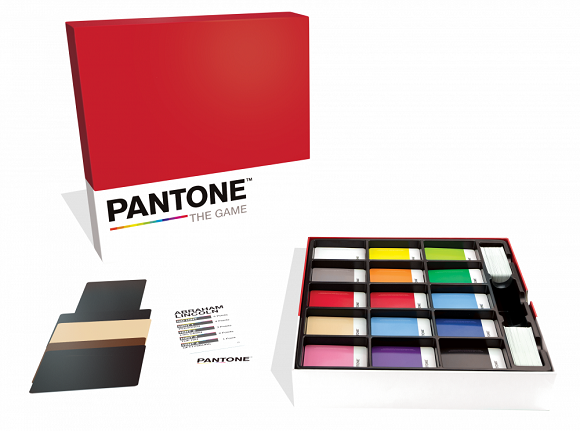Pantone the Game: Tell Your Story with Colors

How abstract can you go and still be able to recognize a well-known figure or a beloved fictional character?
Can you guess Steve Jobs from a handful of colors? Or can you create Lara Croft with just three?
Gameplay
The game contains 60 swatch cards. A swatch card shows a solid color. There are fifteen colors total and four of each color. There are also 132 character cards. At the start of the game each player is dealt four character cards, you discard one and keep the remaining three.
Each round, each player takes a turn being the artist. There are three rounds in total, with each round becoming more difficult for the artist.
On your turn as artist you choose one of your character cards to create. To create your character during the first round, you can use as many swatch cards as you wish. During the second, you can only use one copy of each color, and during the third round you may only use three color cards total.
You have one minute to use the colors to create an abstract picture of your character, after which the other players each get to make one guess as to who the character is. If everyone guesses wrong you give the first clue listed on the character card and everyone has a chance to guess again. If they are all wrong again, you give the next clue. There are four hints in total on each character card. If no one can guess the character after all four hints, no one gets any points. If someone is able to guess the character then she and the artist score points based on how many hints have been given.
The player with the most points after three rounds wins the game.

Review
Pantone is in the spirit of Imagine, Concept, and Pictionary, but requires players to be a bit more creative, thinking outside the box. Creating characters with nothing but rectangles of color is challenging, especially in the later rounds as the number of colors you are allowed becomes limited.
The clues on the cards become steadily more obvious, starting with giving you a general category and becoming more specific as they go. The final clue for the Steve Jobs card, for instance, is ‘Apple’. This means that players will usually only ever be really stuck if it’s a character or person they’ve never heard of. There’s a certain satisfaction in creating a difficult, abstract image of a character and having players guess it with limited or no clues at all, and it’s satisfying for the guessers as well because they also have to think creatively.
While there are some real people on the character cards, the majority of them are out of movies, TV shows, comics, and video games, and most of the clues require knowing these characters to some extent. If someone doesn’t know pop culture, they’re going to be left feeling left out of Pantone and it’s never enjoyable to spend several minutes trying to guess something, only to discover it’s a person you’ve never heard of before.
The game could use more character cards as you’re going to work your way through them quickly and if you play with the same group enough, you’re going to become familiar with them and how they’re most likely depicted. But with the right group, who all share a similar level of pop culture knowledge, Pantone is a fun and more challenging twist on some recent popular party games.
Pros: Creative, challenging, clues ensure that most cards will be guessed
Cons: Requires everyone to have a relatively equal level of pop culture knowledge, could use more character cards
Disclosure: we received a complimentary review copy of this game.







